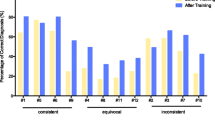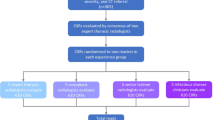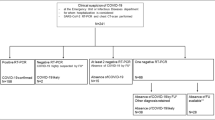Abstract
Our objective was to compare the inter-observer level of agreement in diagnosing pneumonia using the World Health Organization (WHO) guidelines for the interpretation of radiographs. We conducted a prospective study in a pediatric emergency room. Fifteen observers (13 pediatricians, 2 radiologists) interpreted 200 pediatric (<5 years old) chest radiographs using the WHO guidelines. Observers were blinded to the clinical presentation. Results were analyzed for kappa values. Individual readings were compared to two “gold standard” teams: (1) radiologist and pediatrician and (2) two radiologists. Results: Alveolar pneumonia, non-alveolar pneumonia, and no pneumonia were found (by radiologists) in 12.8%, 2.7%, and 78.6% of readings, respectively. The mean kappa values for alveolar pneumonia, non-alveolar pneumonia, and no pneumonia of observers versus the team consisting of a radiologist and a pediatrician were 0.73, 0.23, and 0.61, respectively. For non-alveolar pneumonia, the mean kappa value was higher for the gold standard consisting of a radiologist and a pediatrician when compared to the two-radiologist team. Pediatricians overdiagnosed “non-alveolar pneumonia” compared with radiologists. In contrast, for the alveolar pneumonia and no-pneumonia diagnoses, no significant differences were found. Conclusions: The WHO guidelines for interpretation of chest radiographs result in high level of agreement between readers for the definition of “alveolar pneumonia” and “no pneumonia” but poor agreement for non-alveolar pneumonia. The disagreement with regard to the latter was associated with overdiagnosis by pediatricians, which may lead to overtreatment. We believe that radiographic non-alveolar pneumonia should not be an endpoint for clinical trials and research, nor should it be implemented in clinical setting.


Similar content being viewed by others
References
Albaum MN, Hill LC, Murphy M, Li YH, Fuhrman CR, Britton CA, Kapoor WN, Fine MJ (1996) Interobserver reliability of the chest radiograph in community-acquired pneumonia. PORT Investigators. Chest 110:343–350
Altman D (1991) Practical statistics for medical research. Chapman & Hall, London, p 404
Ayieko P, English M (2007) Case management of childhood pneumonia in developing countries. Pediatr Infect Dis J 26:432–440
Bada C, Carreazo NY, Chalco JP, Huicho L (2007) Inter-observer agreement in interpreting chest X-rays on children with acute lower respiratory tract infections and concurrent wheezing. Sao Paulo Med J 125:150–154
Black S, Shinefield H, Fireman B, Lewis E, Ray P, Hansen JR, Elvin L, Ensor KM, Hackell J, Siber G, Malinoski F, Madore D, Chang I, Kohberger R, Watson W, Austrian R, Edwards K (2000) Efficacy, safety and immunogenicity of heptavalent pneumococcal conjugate vaccine in children. Northern California Kaiser Permanente Vaccine Study Center Group. Pediatr Infect Dis J 19:187–195
Cherian T, Mulholland EK, Carlin JB, Ostensen H, Amin R, de Campo M, Greenberg D, Lagos R, Lucero M, Madhi SA, O'Brien KL, Obaro S, Steinhoff MC (2005) Standardized interpretation of paediatric chest radiographs for the diagnosis of pneumonia in epidemiological studies. Bull World Health Organ 83:353–359
Esposito S, Bosis S, Cavagna R, Faelli N, Begliatti E, Marchisio P, Blasi F, Bianchi C, Principi N (2002) Characteristics of Streptococcus pneumoniae and atypical bacterial infections in children 2–5 years of age with community-acquired pneumonia. Clin Infect Dis 35:1345–1352
Hansen J, Black S, Shinefield H, Cherian T, Benson J, Fireman B, Lewis E, Ray P, Lee J (2006) Effectiveness of heptavalent pneumococcal conjugate vaccine in children younger than 5 years of age for prevention of pneumonia: updated analysis using World Health Organization standardized interpretation of chest radiographs. Pediatr Infect Dis J 25:779–781
Hazir T, Nisar YB, Qazi SA, Khan SF, Raza M, Zameer S, Masood SA (2006) Chest radiography in children aged 2–59 months diagnosed with non-severe pneumonia as defined by World Health Organization: descriptive multicentre study in Pakistan. BMJ 333:629
Jadavji T, Law B, Lebel MH, Kennedy WA, Gold R, Wang EE (1997) A practical guide for the diagnosis and treatment of pediatric pneumonia. CMAJ 156:S703–S711
Korppi M, Heiskanen-Kosma T, Leinonen M (1997) White blood cells, C-reactive protein and erythrocyte sedimentation rate in pneumococcal pneumonia in children. Eur Respir J 10:1125–1129
Leventhal JM (1982) Clinical predictors of pneumonia as a guide to ordering chest roentgenograms. Clin Pediatr (Phila) 21:730–734
Mandell LA, Marrie TJ, Grossman RF, Chow AW, Hyland RH (2000) Summary of Canadian guidelines for the initial management of community-acquired pneumonia: an evidence-based update by the Canadian Infectious Disease Society and the Canadian Thoracic Society. Can J Infect Dis 11:237–248
Margolis P, Gadomski A (1998) The rational clinical examination. Does this infant have pneumonia? JAMA 279:308–313
Mulholland K (1999) Magnitude of the problem of childhood pneumonia. Lancet 354:590–592
Mulholland K, Hilton S, Adegbola R, Usen S, Oparaugo A, Omosigho C, Weber M, Palmer A, Schneider G, Jobe K, Lahai G, Jaffar S, Secka O, Lin K, Ethevenaux C, Greenwood B (1997) Randomised trial of Haemophilus influenzae type-b tetanus protein conjugate vaccine [corrected] for prevention of pneumonia and meningitis in Gambian infants. Lancet 349:1191–1197
Mulholland K, Levine O, Nohynek H, Greenwood BM (1999) Evaluation of vaccines for the prevention of pneumonia in children in developing countries. Epidemiol Rev 21:43–55
Patel AB, Amin A, Sortey SZ, Athawale A, Kulkarni H (2007) Impact of training on observer variation in chest radiographs of children with severe pneumonia. Indian Pediatr 44:675–681
Sarria E, Fischer GB, Lima JA, Menna Barreto SS, Flores JA, Sukiennik R (2003) Interobserver agreement in the radiological diagnosis of lower respiratory tract infections in children. J Pediatr (Rio J) 79:497–503
Schuchat A, Dowell SF (2004) Pneumonia in children in the developing world: new challenges, new solutions. Semin Pediatr Infect Dis 15:181–189
Stein RT, Marostica PJ (2007) Community-acquired pneumonia: a review and recent advances. Pediatr Pulmonol 42:1095–1103
Swingler GH (2001) Observer variation in chest radiography of acute lower respiratory infections in children: a systematic review. BMC Med Imaging 1:1
Virkki R, Juven T, Rikalainen H, Svedstrom E, Mertsola J, Ruuskanen O (2002) Differentiation of bacterial and viral pneumonia in children. Thorax 57:438–441
World Health Organization Pneumonia Vaccine Trial Investigator's Group (2001) Standardization of interpretation of chest radiographs for the diagnosis of pneumonia in children. WHO/V&B/01.35. World Health Organization, Geneva
Wilkins TR, Wilkins RL (2005) Clinical and radiographic evidence of pneumonia. Radiol Technol 77:106–110
Wubbel L, Muniz L, Ahmed A, Trujillo M, Carubelli C, McCoig C, Abramo T, Leinonen M, McCracken GH Jr (1999) Etiology and treatment of community-acquired pneumonia in ambulatory children. Pediatr Infect Dis J 18:98–104
Young M, Marrie TJ (1994) Interobserver variability in the interpretation of chest roentgenograms of patients with possible pneumonia. Arch Intern Med 154:2729–2732
Zenteno AD (2008) Utility of chest x-ray like approach to etiology of community acquired pneumonia in children. Rev Chilena Infectol 25:17–21 [Article in Spanish]
Conflict of interest
The authors have no conflict of interest or financial relationships relevant to this article to disclose.
Author information
Authors and Affiliations
Corresponding author
Rights and permissions
About this article
Cite this article
Ben Shimol, S., Dagan, R., Givon-Lavi, N. et al. Evaluation of the World Health Organization criteria for chest radiographs for pneumonia diagnosis in children. Eur J Pediatr 171, 369–374 (2012). https://doi.org/10.1007/s00431-011-1543-1
Received:
Accepted:
Published:
Issue Date:
DOI: https://doi.org/10.1007/s00431-011-1543-1




